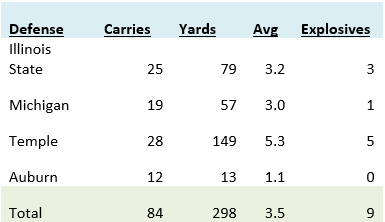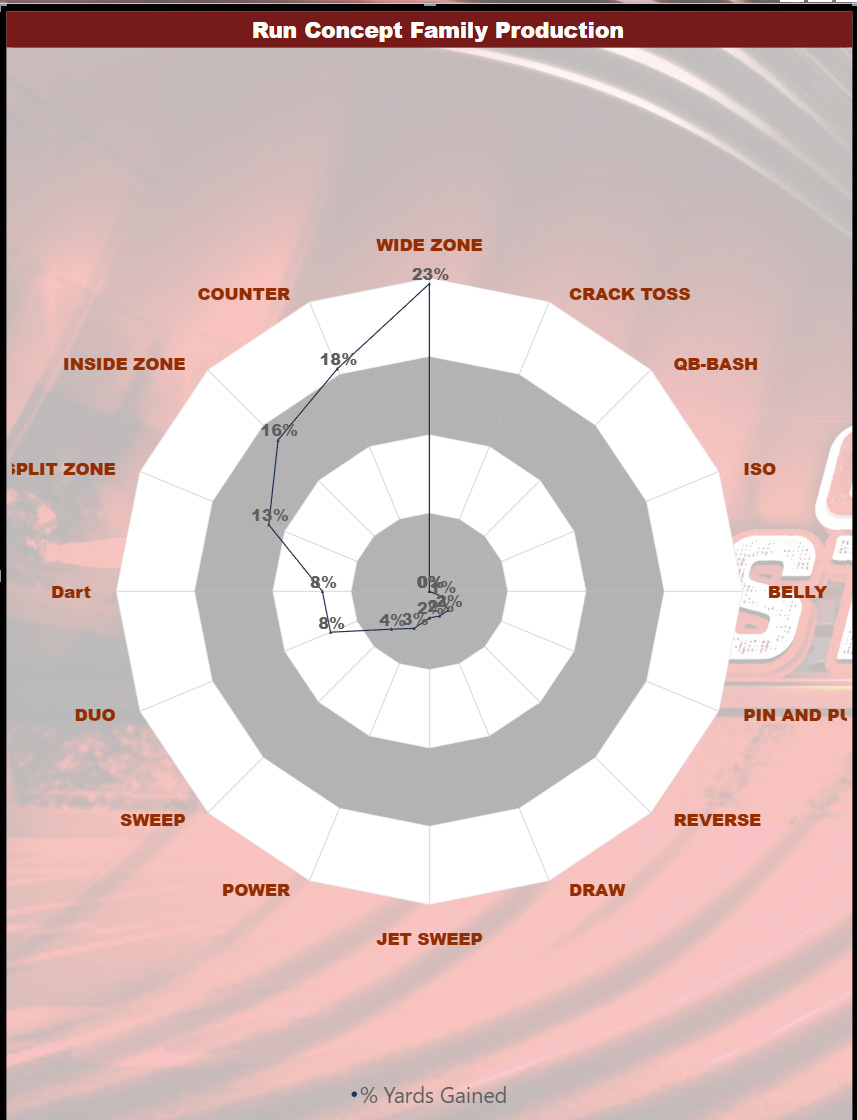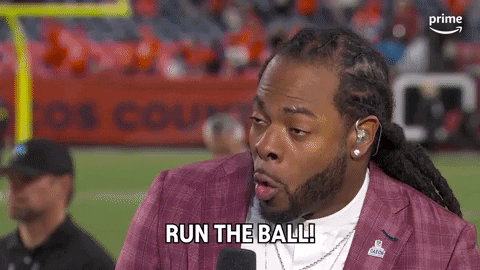One of the early frustrations with this offense is the muted rushing attack. We essentially opened the year with a third-string offensive line against Illinois State, and the group gutted it out while banged up at Auburn. Now, here’s the lens I’m using: through four weeks in 2024, Washington State produced 30 explosive runs (John Mateer 16, RBs 14). OU sits at 16 total explosives so far, with 9 from the running backs—none against Auburn and just one against Michigan.
Running back production
Missing Element No. 1: Where’s the Wide Zone?
Having a wide zone answer to the backside collapse in counter would be phenomenal. Running wide zone, if the defender decides to vertically push up field. The Guard or Tackle on the backside can “throw his ass” out of the club. Take him for a ride into oblivion.
In 2024 at Washington State, Wide Zone was the RB engine—23% of rushing production from the backs came from it, with 9 explosives in the first four games. Over the first four weeks that year, Arbuckle called it 16 times for 86 yards (5.0 per) and 4 explosives. This season: 13 calls for 37 yards (2.8 per) and zero explosives. That’s a glaring hole in the profile. In my opinion that is a huge element missing in this offense.
There are two mainstream Wide Zone families.
(1) “Run” , the version Missouri leans on. Missouri shows what it looks like when it’s humming: 195 rushes for 1,192 yards (6.11 YPC) and 13 TDs through four games—about 48.8 carries and 298.0 yards per game.
(2) Square Drag which was very successful by the Oklahoma State and Melvin Gordon which is a more passive approach on the play side with Ts and TEs square drag horizontally forcing defenders gap integrity rules against themselves.
Ben Arbuckle comes from the “Run” family.
On re-watch, I can’t tell which Wide Zone progression we’re teaching; the timing isn’t married and the playside stops its feet. We need real horizontal displacement and, above all, the back must finish his track to force the safety to declare. The synchronization and timing is off. The playside blocks stall. That can’t happen. Landmark/footwork are out of phase and the playside combo isn’t running. Create width, keep feet through contact, and let the back ride the track to manipulate the safety.
We’re not comfortable in it yet. Maikkula has the toughest assignment at center and is often at a leverage disadvantage, but it still has to get done. He looks to square drag he’s trying to handle the nose, loses too much ground, he’s out of phase with the back, which throws off the cut timing. Playside isn’t creating horizontal width, so the runner can’t finish his track. Simmons is stopping his feet on contact, which is a hard no.
Outside of Wide Zone, the line has held up: they anchor in pass protection and read Counter well. We’ve had Wide Zone circled at Champion Standard because it’s relatively new to recent Sooner football; you probably have to go back to Kevin Wilson in 2008 with DeMarco Murray for the last real commitment, and DeMarco later excelled on wide zone under Chip Kelly (Eagles). Right now the playside isn’t creating horizontal width, Maikkula is in a tough leverage spot on some of these blocks, and the backs are late to puncture. They’ll keep hammering it. Arbuckle isn’t a big pin/pull coach, but he may need more perimeter answers as a counterpunch until it clicks. When Wide Zone comes online, RB production should jump.
Missing Element No. 2: Protect the Backside on Counter
Counter is boom-or-bust—you’re vacating two gaps and reading blocks frontside. Against Auburn, the RB counter showed up just four times for -2 yards. They beat it with backside DT/edge run-throughs that disrupted the pullers and even led to the Mateer fumble. Auburn wrecked the backside on a couple of the reps that led to dead plays.
We have used Jet Sweep to freeze the end—our most effective counter look.
Bottom line: the backside wasn’t protected well enough.. Until we moved to GY Counter, we cap the backside with our Tackle but Tory doesn’t read his block.
Missing Element No. 3: Opportunity
The QB run game buys you +1 or +2 in the box, but living on it turns into hero ball. It’s not sustainable over four quarters or four months. If you want the backs involved, commit to them: script early RB touches, keep the ball on their track on first down, and use the QB as a change-up, not the meal. Protect your quarterback for third down and the fourth quarter; let the RB room absorb the body blows that set up explosives later.
In short: Counter chaos with an unprotected backside, struggling running back reads and no Wide Zone will make life hard on the rushing attack and pushes the QB into Hero ball. We have two weeks to major in Counter by adding more backside run attachments (add speed option) or light the Wide Zone fuse.
Give me some of this..
Defensive coordinators can be predictable. If you show you’re willing to do something and hit an explosive play or a boom play (20+ yards), you force them to give something up. Major in counter and add attachments to protect the backside, including RPOs.
Summary:
Keep developing the Wide Zone.
Protect your backside in Counter.
RBs Run through the damn smoke!
Commit to the Backs as a playcaller.
And!
Thank you for reading!
Lets keep building out this tailgate party!
Boomer!
Rob




